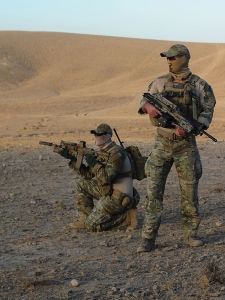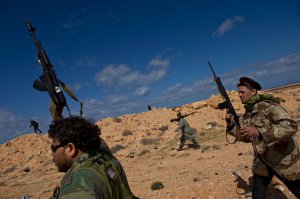Please note: a number of serving Australian Army officers and soldiers were interviewed for this piece. Their names have been withheld at their request.

Last November the Minister for Defence Materiel, Jason Clare, announced that Australian troops operating in Afghanistan would be issued with Crye Precision MultiCam uniforms, following a successful trial. Australian special operations units had been wearing the pattern for some time, and the decision to expand its use to all troops in the theatre was a direct result of the positive feedback received by SOTG members. In late May of this year Chief Executive of the Defence Material Organisation, Dr Stephen Gumley, announced that the DMO had reached “an arrangement with the Crye company for them to design an Australian version of their pattern in the various materials”.
There have, however, been concerns about the final design, colouration and testing of the pattern, and some concerns from local industry and politicians.
The rise of MultiCam
The current, US-issue MultiCam pattern is already in service with a number of militaries, law enforcement organisations and private companies. The US Special Operations Command have been using the pattern for years now, and MultiCam had previously featured in various iterations of the US Army’s futuristic Future Force Warrior/Land Warrior program (cancelled in 2007).
Some of the first ‘real world’ adoptions of the camouflage came from the private sector, however. Blackwater tested MultiCam with some of its teams early on and featured the pattern in its ‘Pro Shop’ also (leftover product). Private contractors I have spoken to and worked with have also recognised the utility of MultiCam in Afghanistan, despite the tendency to avoid camouflage patterns.
The pattern is also in use with the US Immigration and Customs Enforcement Special Response Teams and a number of other US law enforcement agencies, some units of the British military (whilst awaiting the roll-out of their very own licensed Crye pattern, MTP) and the Australian Federal Police.
The UK has also adopted a variation of MultiCam. The Ministry of Defence’s Defence Science and Technology Laboratory (DSTL) investigated the effectiveness of ten different camouflage patterns under the PECOC (Personal Equipment Common Operating Clothing) program. The assigned team conducted a wide range of tests, used computer modelling, developed several experimental techniques and tested the pattern in the UK, Cyprus, Kenya and Afghanistan. MultiCam, already in use by UK special operations forces, was the stand out of the test group. Crye was then asked to develop an exclusive pattern for the UK MoD. As one Crye representative said: “MultiCam won all their trials so they wanted us to develop a pattern for them that performed like MultiCam but had a distinctly British identity. UK-MTP is the result”. The pattern itself, properly called Multi-Terrain Pattern, features the familiar MultiCam colour palette in a design featuring brush-like strokes reminiscent of its predecessor, British Disruptive Pattern Material (DPM).
MultiCam for the ADF
The new Australian pattern will be developed for the ADF by Crye at a cost of US$3.1 million. Additionally, Defence will be licensing the rights to manufacture uniforms in the existing pattern, for a sum of US$4.7 million. The Australian pattern will be known as ‘Australian MultiCam Pattern’ (AMP). At this stage it is unclear whether AMP will feature the current MultiCam palette in a distinctly Australian pattern, in a similar approach to the UK’s MTP, or will also feature a colour range modified for Australian terrain. It is also unclear how widely uniforms in the new pattern will be distributed, and whether they will be issued for use in Australian terrain. Previous proposals, however, have not fared so well.
Around late March and early May of last year, a number of sources began reporting on the Australian Army’s field testing of a new ‘mid-point’ camouflage uniform, designed to “better meet the range of environments deployed troops are encountering”. Disruptive Pattern Midpoint Uniform (DPMU), or ‘vomit cams’ as two of the serving soldiers I interviewed referred to it, was a DSTO (Defence Science and Technology Organisation) project to develop an ‘Australian’ pattern camouflage in a colourway optimised for semi-arid regions. There were allegations made during the testing of this pattern that it had essentially been pre-selected for distribution, regardless of the outcome of the field testing. It was also stated that other patterns (the “US and UK solutions”) were undergoing testing at the same time as DPMU, however the AMP pattern was not mentioned at this stage.
Australian troops I spoke to have mixed feelings about the idea of introducing a new ‘Australian MultiCam’ to replace the DPCU pattern. The utility of the current-issue MultiCam pattern for overseas deployments – referred to in Australian service as Crye Precision Camouflage Uniform (CPCU) – has been widely acknowledged by Australian troops. As one serving Australian Army officer put it: “The MultiCam pattern is excellent for Afghanistan because of the relatively small distance between desert areas and green zones there, and the fact that we often have to operate in both of those areas as part of one operation”. However, the same officer went on to say that whilst the utility of the pattern for work in Afghanistan was widely acknowledged, there was an uncertainty as to how well the current colour palette would suit the Australian bush. DPCU, based on aerial photographs of Australian terrain and designed specifically for the country’s bushlands, is held in high regard by many of our troops. A serving digger interviewed stressed that DPCU is ideally suited for use in Australia and that, in his opinion, MultiCam (as it stands) should be reserved for troops deploying overseas. While it is unlikely, due to issues of cost, that two sets of uniforms (and spares) will be issued to all Australian-based ADF personnel, it may be that MultiCam is issued in anticipation of overseas deployment. It will be interesting to see how the balance will be struck.
The Crye uniforms currently being issued have gained a lot of their popularity with troops not just from the MultiCam pattern, but from the design of the uniforms themselves. Of course, there have been a few hiccups, notably in sizing. Nonetheless, several serving troops and officers I spoke with pointed out a number of design features that were very popular. The rip-stop fabric, location of pockets, knee and elbow padding, and cooler fabric designed for use under body armour were the stand-out features. It should be noted that these features are not exclusive to Crye’s range of products, and could be incorporated into uniforms produced in Australia using a licensed Crye pattern, or any other camouflage design.
Australian industry concerns
There has been some outcry (see comments section here) about the non-competitive adoption of a foreign camouflage pattern. The Shadow Defence Minister, David Johnston, has also asked for comment on the matter. Unfortunately for Australian designers and producers, MultiCam has a noted track record and enjoys a high-level of support from the troops. Of course, if the new AMP pattern turns out to be very similar to DPCU but featuring Crye’s colour palette (in the same vein as the UK’s MTP), one could reasonably ask why such a relatively minor change couldn’t have been conducted by an Australian company. Additionally, a shift towards Crye patterns by the US, UK, private sector companies and now Australia has the added effect of diminishing differences in appearance between various Western militaries.
One thing is for sure though, Crye Precision continues to represent what Western militaries believe is the vanguard of camouflage design, and will no doubt continue to be financially successful as a result. For the new AMP pattern to be successful it will require proper theoretical and operational testing in the environments it is expected to serve. If we decide to issue such a pattern to troops stationed in Australia, then it is my sincere hope appropriate tests are conducted in Australian terrain. Wise doctrinal guidance outlining the scope of deployment for the new pattern will also be necessary, and it will be interesting to see whether we arrive at a pattern designed to replace DPCU, or a pattern designed specifically for expeditionary use.
Addendum: We may well see an announcement of further details at Defence and Industry 2011, in Adelaide next week (28th – 30th June).
This piece has also appeared at KitUp!


